Estimates of Collision Risk of Harbour Porpoises and Marine Renewable Energy Devices at Sites of High Tidal-Stream Energy
The aim of this study was to investigate how often porpoises occurred in two areas of immediate interest for tidal-stream development on the west coast of Scotland. These two sites were the tidal narrows of the Sound of Islay (between the islands of Islay
Section 2: Use of Novel Acoustic Methods to Investigate Porpoise Occurrence in Tidal-Sites
Odontocete cetaceans use echolocation to navigate and locate prey. The echolocation sounds of harbour porpoises are intense, specific in their frequency structure and emitted in characteristic bursts or trains. As a result it is possible to electronically pick out these underwater calls from background noise (with increasing levels of sophistication) automatically. The towed hydrophone in Section 1 was used to detect such calls from a boat moving in predefined transects. Here we assess three other techniques using this acoustic feature of harbour porpoises to investigate their (a) temporal occurrence, (b) spatial occurrence and (c) diving behaviour.
A number of automatic porpoise click detectors have been developed in recent years with some being built into entirely autonomous systems. The only commercially available version of this technology is built by Chelonia Ltd and called PODs. Of these, the most recent version is the C-POD. This device uses digital waveform characteristics to detect odontocete clicks and logs the time, centre frequency, loudness, duration and bandwidth of each. Thus, in addition to porpoises they can also detect species such as bottlenose dolphins and killer whales and to a lesser extent successfully classify them. Other parameters are also recorded including orientation relative to vertical ( i.e., the extent to which the device is deflected by the current), temperature, boat sonar occurrence and relative levels of background noise. C-PODs are housed in relatively small tubes (66 cm long, 4 kg in air) and have sufficient battery and memory capacity to remain submerged and operating for several months at a time (usually ~ 3 months).
C-PODs (and their previous version T-PODs) have been widely used to investigate porpoise occurrence and particularly temporal patterns for a wide range of studies ranging from porpoise ecology, to fishery interactions and more recently their occurrence in areas of interest to wind-farm construction (Scheidat et al., 2011). The deployment of these devices in tidal-stream areas to understand porpoise occurrence is therefore attractive. However, their utility in this environment has not been fully investigated. Of particular concern is whether it is possible to successfully moor the devices in an upright position and whether they can detect porpoises against the high levels of turbulence, sediment transport and general background noise typical of tidal-stream sites. To explore this issue, we attempted to moor C-PODs in the Sound of Islay in 2009 and around the Kyle Rhea in 2010.
2.1.1 PODs in the Sound of Islay
Moored C-PODs were deployed in the Sound of Islay in September 2009, in two locations. One POD (" POD 664") was weighted with 3 kg of lead and chained (with Northern Lighthouse Board permissions) to an existing navigation buoy (Black Rock Buoy 55°47.5 N 6°04.0 W). It was suspended so that it would be three meters below the surface in water about 25 meters deep near to the middle of the Sound. The second (" POD 666") was moored with ropes and mooring weights off the shore at the Carraig Mor lighthouse (55° 50.3 N 6° 4.1 W). This position was much closer inshore (150 m from the beach) but immediately adjacent to the site of interest to the tidal-stream industry. It was floated about two meters off the bottom in 10 m of water and given 10 kg of positive buoyancy using incompressible pellet floats. Both sites experienced the full tidal stream. Two episodes of deployment were tested. The first occurred in mid-September 2009 for three to five days and the second ran for longer from late September into the winter of 2009.
On recovery after the first deployment the PODs from both sites were clearly influenced by the currents (device tilt data). However the recorded patterns were different. The Carraig Mor POD (bottom, shore-line mounted) was not strongly influenced by currents, showing only moderate deviation (20-30º) from vertical and only on one direction of flow. In contrast, the Black Rock Buoy POD (surface, mid-channel mounted) was heavily influenced by currents both during ebb and flood flows. This was to the point where the POD was only rarely in the correct upright position and was frequently pushed to be near horizontal (see Figure 14).
High levels of ambient noise impact the ability of C-PODs to detect porpoise clicks. This occurs in two ways - firstly by masking the clicks and making them difficult for the software to detect and secondly by rapidly filling up the device's recording buffer with other non-cetacean click detections. The first effect is difficult to quantify but the second is easily measured because it truncates the fraction of each minute recorded. These "fractions of lost time" can be used as a rough measure of the ambient noise levels in the surrounding environment. The Carraig Mor POD 666 experienced only limited data loss in this manner, indicating that it was deployed in a relatively quiet environment and should not have missed porpoise echolocation events should they have occurred. In contrast the Black Rock Buoy POD lost much of its recording time due to excessive ambient noise. Overall in the first short deployment, no porpoise clicks were detected by either POD. However, both did detect dolphin click trains at various points during their deployment and coincidentally we observed bottlenose dolphins in the area during that week.
The longer-term deployment of PODs was less successful. When the Northern Lighthouse Board serviced the Black Rock Buoy in the winter, neither the POD nor its tethering chain was still present on the attachment point. We suspect either excessive wear from the near continuous flow had worn through the 5 mm chain and / or galvanic action between the metal buoy and chains had preferentially eroded our chain and the device had come loose. The Carraig Mor mooring fared no better and the tether rope was found to be chafed through and the POD missing. Since neither POD was retrieved no data could be recovered.
Overall, the Sound of Islay POD experience showed that tethering PODs in tidal waters is problematic, both from the practical perspective of keeping gear orientated correctly, and for long enough to be useful, but also from the point of the resulting porpoise detection data being limited by the levels of background noise. Mooring techniques can be improved but the background noise issue is particularly problematic because it scales with the tidal flow and the occurrence of porpoises during high flow periods is a key parameter of interest.
Figure 14. POD deviations from vertical in response to currents, Sound of Islay, September 2009. The cyclic nature of these deviations demonstrates the tilt resulting from the flow of water past the device.
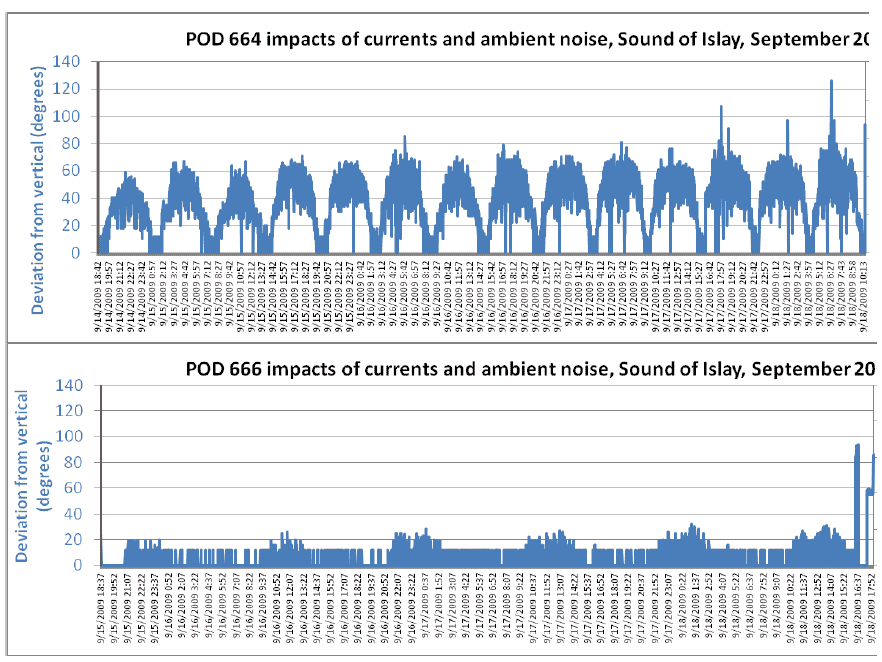
2.1.2 PODs around the Kyle Rhea
Following the lessons learnt from the Sound of Islay POD work, a second trial was performed around the Kyle Rhea area coincident with the May 2010 visual and acoustic boat surveys (Section 1). One POD (#666) was moored in a non-tidal site 16 km from the Kyle Rhea (and acting as a control) near Tartar rock (57° 6.8 N 5° 48.7 W) on the Skye side of the southern Sound of Sleat. A second POD (#664) was deployed at the southern mouth of the Kyle Rhea in a site immediately next to (but out of) the main ebb flow (57° 13.4 N 5° 39.0 W). A third POD (#668) intended for other experiments was used opportunistically first in the entrance to Loch Duich to the North of the Kyle Rhea (57° 16.3 N 5° 31.5 W) and then in the Northern Sound of Sleat at the point where the full force of the ebbing tide from the Kyle Rhea meets the mainland shore (57°12.2 N 5° 38.7 W). All moorings were bottom mounted in 15-20m of water with vertical risers to surface floats and the PODs suspended 5 m off the bottom. Deployment durations ran from approximately 2 to 4.5 days.
The control POD in the non-tidal southern Sound of Sleet malfunctioned during deployment and did not record any data. In contrast the POD at the southern entrance to the Kyle Rhea functioned well and the on-board inclinometer indicated only moderate deviations from vertical (out to approx. 40º) roughly every 12 hours, during periods associated with flooding (north-going) tides (Fig 16). Noise levels did truncate some of the monitoring but showed no obvious relationship to tidal currents or time of day. Over its 4.5 day deployment it detected few porpoises. The automatic C-POD software logged five intense echolocation events (18-60 clicks per minute). All of these occurred between late evening and early morning around ebbing/low tide. No such click events were recorded during the equivalent tidal state during daytime. These events offered too small a sample size to draw conclusions so the detection data were manually examined to see if there were other likely porpoise events that fell below the software's trigger threshold. Doing this revealed another four events. These also only occurred at night ( Figure 15). While this evidence is not conclusive it does suggest that porpoise use of this area was both tidally and diely influenced.
Figure 15. Relative distribution of porpoise clicks and average hourly deviations from 0º (vertical orientation) recorded by C-POD 664, moored at the southern entrance to Kyle Rhea from 16-20/05/2010.
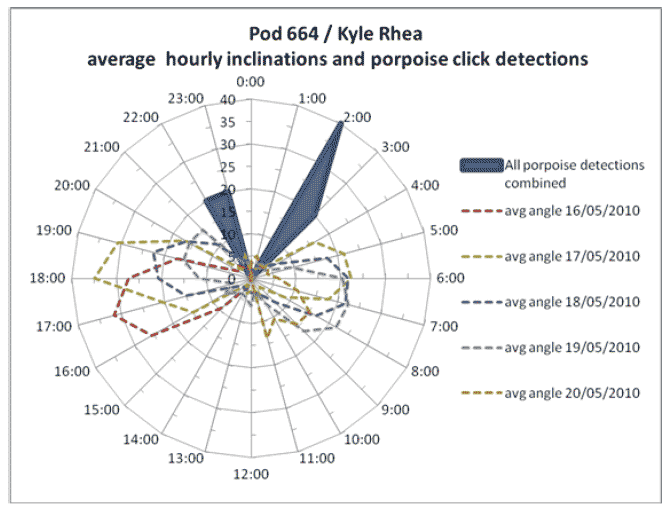
The opportunistic POD was initially deployed for half a day in Loch Duich during the testing of the vertical hydrophone array (see Section 2.3), then for two days next to the boat's overnight anchoring position at the mouth of Loch Duich and then finally for two days in the northern Sound of Sleat. Comparatively low levels of noise were recorded during the deployment, particularly in the Sound of Sleat North area. In contrast to the C-POD at the southern entrance to Kyle Rhea this one detected frequent porpoise clicks (between 7-111 clicks/minute) at all locations with no obvious correlation between tidal or daylight cycles with porpoises apparently present in these areas at all times ( Figure 16). Particularly interesting is the comparison of the detections in the northern Sound of Sleat. Despite the recorders being less than 3 km apart, one (immediately next to Kyle Rhea) recorded porpoises only at very specific times while the other logged them throughout the deployment. Both sites were very strongly influenced by the tidal flow.
Figure 16. Relative distribution of porpoise clicks and average hourly deviations from 0º (vertical orientation) recorded by A) POD 668, moored in Loch Duich from 16-17/05/2010, and B) POD 668, moored in the Sound of Sleat North from 18-20/05/2010, over 24-hour periods.
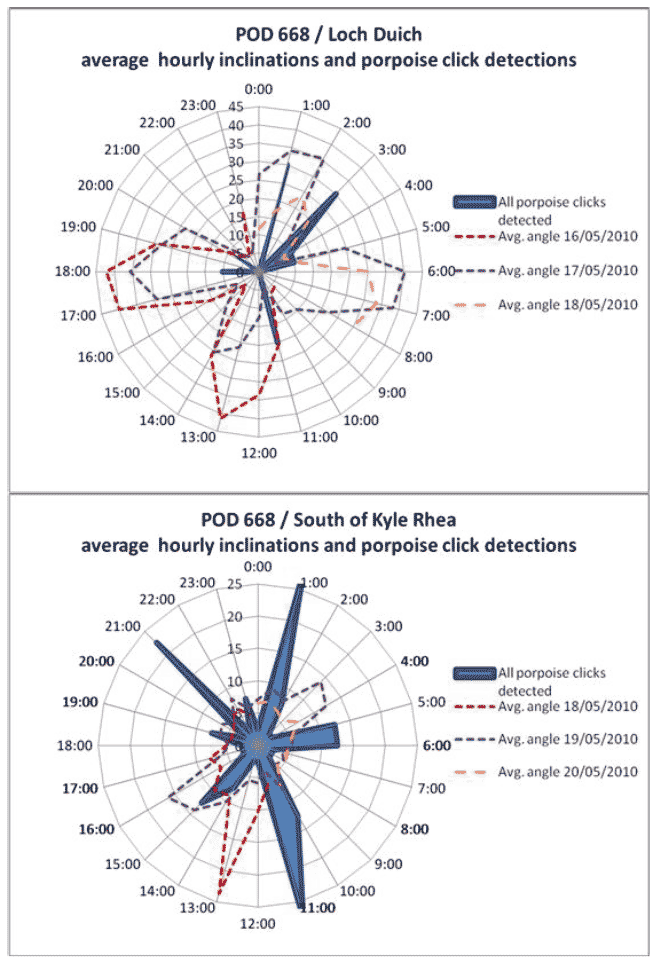
2.1.3 Lessons learnt from mooring PODs in tidal sites
PODs have proved useful and informative (with caveats) for studying porpoise occurrence in a wide variety of locations at sea. Accordingly, these devices are potentially very useful for monitoring tidal sites. However, these locations present specific challenges that cannot be overlooked. The main four are outlined below.
First it is technically difficult to moor PODs correctly in fast flowing water. The flow-induced drag on any equipment means that substantial anchoring is needed to secure the devices to the seabed and with rocky substrate being typical heavy chain or blocks are needed rather than (lighter) sediment gripping anchors. Heavier gear requires larger boats for deployment and retrieval. The drag on any ropes also means that surface floats for location and retrieval may spend very little time actually at the surface. In tidal-stream sites it is very likely that floats (other than very large ones) will be dragged underwater on both flood and ebb tides. Once the surface float is submerged, the (now snaking) bottom to surface line then runs the risk of snagging on the seabed and so not allowing the buoy to return to the surface on slack tide. Incompressible floats are also needed to ensure they retain their buoyancy once submerged. With "surface" gear being dragged under when the tide runs the time windows for device recovery become very short. For example the tidal flow that was "slack" enough for our buoys to surface in the Sound of Islay at springs was in the region of six minutes. Servicing multiple devices then becomes problematic.
The second substantial issue is wedded to the difficulties of keeping bottom to surface lines vertical (see above). This is the problem of simultaneously keeping the PODs themselves vertical and up in the water column. While their default setting of PODs is to turn themselves off once they fall horizontal this can be turned off. However, the detection capabilities of knocked-down PODs are likely to be different to correctly deployed ones. This is likely to bias any temporal comparison of porpoise occurrence in tidal sites.
Thirdly, with heavy anchoring equipment combined with near-continuous water motion all the way to the seabed leads to substantial wear on the mooring tackle itself. We experienced rope and chain chaffing through on our two longer term deployments with the resulting total loss of both the equipment and the data. Mooring loss is relatively common for scientific equipment and without recovery the reason for this usually remains unresolved. Removal through fishery interactions is likely for many sites but rapid gear failure is an expected additional issue in tidal sites.
The three issues outlined above are all technical and are likely to be resolved in the coming years with sufficient effort, resources and experimentation. A final one is more challenging because it is an inherent aspect of the acoustics of these sites themselves - namely that as the tide flows, the broad spectrum background noise increases massively so that it can overload the click detection capabilities of the POD and also mask the porpoise calls themselves. Because background noise varies with tidal flow it then becomes difficult, or impossible, to truly relate porpoise occurrence to tidal flow conditions. No direct fix for this is obvious other than careful site selection based on ambient background noise. It must also be remembered that this background noise may influence the porpoises directly as their echolocation requires the successful reception of the low-level echoes returning from their outgoing clicks. The resilience of their echolocation to high levels of background noise is little known but it has been suggested that porpoises either leave such areas during times of high background noise or, more problematic here, cease echolocating.
Given these issues, the results from our trials (Kyle Rhea in particular) showed that porpoises can be detected with careful device placement and that patterns of detection may vary at relatively fine spatial scales. Thus multiple simultaneous deployments are likely to be required to properly understand how animals use these areas.
Finally, in the Sound of Islay deployment we detected dolphins on several occasions and indeed saw bottlenose dolphins in the area whilst waiting for buoys to surface at slack tide. Such POD deployments are therefore informative for other species as well as harbour porpoises so long as direct observations can ground truth the actual species beyond simply "dolphins" as identified by the current C-POD software.
2.2 Spatial occurrence
The section above ( 2.1) demonstrated several problems with deploying fixed recorders in tidal streams, however the detection and logging capabilities of PODs remain highly attractive in studying porpoise occurrence. Likewise the use of a boat to survey an area and detect porpoises either visually or acoustically offers clear perspectives on likely habitat use at scales relevant to the tidal-energy sites. Boat surveys are however labour intensive and expensive which together typically results in relatively short time windows being available to study animal occurrence. Here we explore the possibility of combining the benefits of these two approaches along with a key property of tidal sites (vigorous flow) to develop a new method to study porpoise spatial distribution. For this we took standard C-PODs but freed them of their moorings and instead attached them to a drogue designed with surface floatation and position fixing capabilities. We then released this equipment upstream of the site of interest and let it flow with the tide over the area before retrieving it. Porpoise detections recorded on these "Drifting PODs" could then be mapped. (The method is more fully described in Wilson et al., In Press).
To build a Drifting POD, we took the standard C-POD and tethered it to a weighted coastal-water drogue which was itself attached to a dan-buoy fitted with GPS recorder and high visibility flag ( Figure 17). The POD was mounted so that it was vertical 5 m below the surface. To test the concept we used a RIB to release a pair of these drifters into the Kyle Rhea tidal stream simultaneous to running the visual and acoustic boat surveys in May 2010 (see Section 1). The location data logged on the GPS recorders were then matched to POD data on a minute-by-minute scale.
These tests were performed 23 times (14 on May 18 th, and 9 on May 20 th, 2010) on both flooding and ebbing tide. Figure 19 shows the spatial distribution of these drifts and since the units recorded a location once a minute the spacing of the dots in each track gives a visual indication of drift rate. On May 18 both PODs were released 7 times in succession within the Kyle Rhea Central Channel on the falling tide. Once released the devices made rapid progress with the tide down and into the northern Sound of Sleat before being retrieved and reset. The average deployment time was 29 minutes ( SD of 12 minutes) during which the PODs travelled, on average, 2.0 km downstream ( SD = 0.9 km) before being retrieved. Calculated on a minute-by-minute basis, these C-PODs attained an average speed of 1.1 m.s -1 over the ground ( SD=0.4 m.s -1), or around 4 km.hr -1. On May 20, 4 releases took place at the southern entrance of Kyle Rhea (on the northerly flood tide), one from the middle of the Central Channel (around high tide) while the remaining 4 releases occurred at the northern entrance (on a southerly tidal flow). Average deployment time here was 66 minutes ( SD = 24 minutes), during which the PODs travelled, on average, 3.2 km ( SD = 0.8 km). During these deployments, the PODs travelled at an average speed of 0.9 m.s -1 ( SD = 0.4 m.s -1). Drifting speeds of up to 3.2 m.s -1 and as low as 0.03 m.s -1 were recorded during the course of these deployments.
In terms of tidal coverage overall, two deployments (of the drifter pairs) occurred within an hour before high tide (moderate northward flow) and a single deployment occurred immediately after high tide (slack water). All other deployments occurred as tides were falling until approximately 30min before low tide (strong to moderate southern flow). Highest speeds (>2 m.s -1) were encountered in 2 areas: in the middle of the Central Channel just north from its narrowest section where water flowing southward gets compressed and slowed down, and from that narrowest section southward to the uppermost parts of Sound of Sleat North, where most PODs were swept out of the Central Channel of Kyle Rhea by a strong jet feature of the tidal current. This jet feature, as indicated by the PODs' travelling speeds, did not extend much beyond the 50m isobath of the Sound of Sleat North (see Fig.18). Conversely, some of the lowest speeds (<0.5m/s) were encountered in the middle of the Central Channel, where PODs were sometimes captured in eddies or peripheral surface currents and returned in the direction from which they had originally come.
Processing of the data held by the PODs revealed that they did record porpoise click trains (25-61 clicks.min -1). All of these were detected on deployments on the May 18 ebb tide tracks and all of these detections occurred once the drifters had left the Kyle Rhea proper and had entered the deeper waters of the Sound of Sleat North area (black stars Figure 18). This was the area that the survey boat Silurian also visually and acoustically detected the majority of its porpoises in the greater Kyle Rhea area. The drifters recorded no porpoises in the Kyle Rhea channel itself. It must be noted that because the drifters moved with the current, multiple detections of porpoises on the same drift were not necessarily independent. This feature distinguishes the drifting acoustic method from the powered boat-towed method which wouldn't suffer from this bias.
In addition to porpoises, the Drifting PODs also encountered high levels of ambient noise. When severe, these sound quickly filled up the devices' one-minute buffer. We were able to investigate the occurrence of this background noise by plotting it as fractions of each minute truncated by the buffer saturating. Noise levels were low (0-20% of each minute lost) during most of the deployments, but reached high levels (>40% lost) in particular areas (see Fig.19). These high levels of ambient noise were confined to the narrowest section of the Central Channel when the tide was in mid-flow. Noise levels rapidly fell as the tide slowed. A comparison of these results indicates that a zone of significant ambient noise is created locally within the Central Channel of Kyle Rhea during at least the falling tide, within which the ability of PODs to record cetacean vocalisations is severely curtailed. This area is one of the places where current speed was greatest; however, PODs subjected to comparable current speeds south of the Central Channel suffered far less interference. More importantly, as the PODs are passively drifting with the current, water movements past the acoustic sensors cannot be responsible for this noise. Because the ambient noise was relatively restricted in space and time, the levels experienced would most likely have allowed the detection of harbour porpoise clicks along most of the drifters' transects.
The Drifting POD trial appeared to be successful. We were not only able to survey a relatively large area using just two devices, two people, a small boat in only two days but we found a similar (albeit less detailed) result than the much more intensive and costly boat surveys [2] . In addition, the drifts revealed spatial and temporal structuring in background noise. Crucially this was noise that limited the abilities of the PODs to record echolocation sounds. Thus we were able to rapidly provide data that would inform the appropriate placement of moored PODs in future.
Figure 17. Schematic of the components of the Drifting POD equipment. The ropes and flotation was designed so that the hydrophone in the POD was suspended 5 meters below the surface.
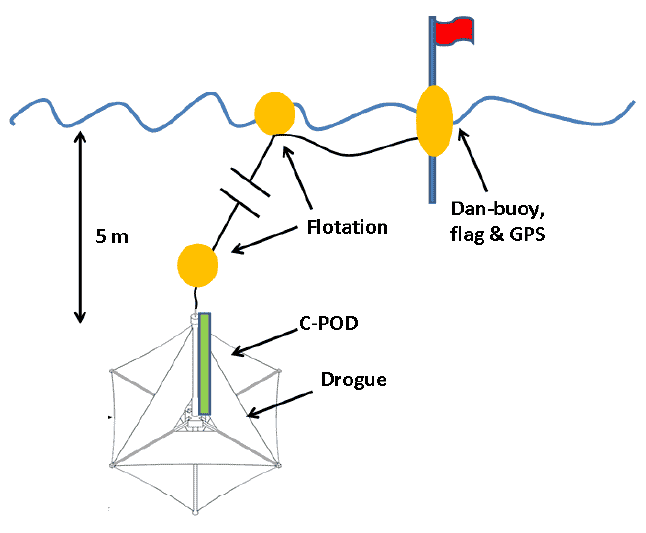
Figure 18. Trajectories followed, and flow speeds experienced, by consecutive deployments of drifting C-PODs in Kyle Rhea (1-minute averages) during May 18 and 20, 2010. All deployments on May 18 were southward-flowing, while there was a mixture on May 20 (see text). Note that highest flow speeds were concentrated in two areas on either side of the narrowest section of the Central Channel of Kyle Rhea. Locations of porpoise click event detections and moored C-PODs are indicated.
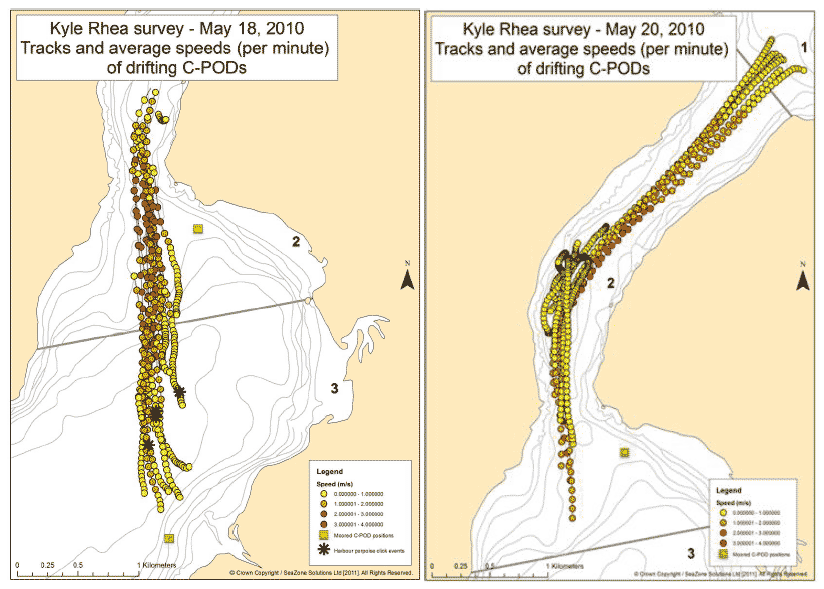
Figure 19. Ambient noise levels recorded during consecutive deployments of drifting C-PODs in Kyle Rhea (1-minute averages) during May 18 and 20, 2010. Loudest ambient noise levels (>80% of each minute in recording time lost) occurred in a comparatively localised area north of the narrowest section of the Central Channel. Locations of porpoise click event detections and moored C-PODs are indicated.
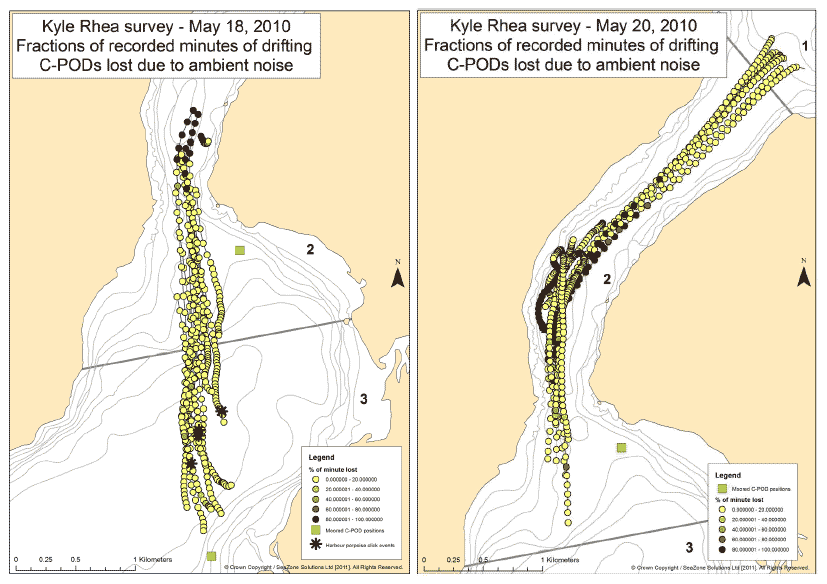
The underwater behaviour of porpoises at tidal energy sites, and in particular the proportion of time they spend at different depths, is highly relevant to any realistic assessment of collision risk. Because tidal narrows are such physically unusual habitats we can't expect animals to behave within them in the same way as they have been documented to do elsewhere. Thus, extrapolation from dive behaviour recorded in other locations is not possible and instead, diving behaviour must be measured somehow in tidal areas during periods of high current flow.
Studies to investigate porpoise diving behaviour have primarily targeted the use of telemetry tags attached to free swimming porpoises. These are currently unsuitable for looking at porpoise behaviour relative to tidal turbine collision risks, because there is no guarantee that a porpoise once tagged will spend any time near a habitat of this type and also opportunities to tag porpoises in the UK are virtually non-existent. Alternative methods using Sonars show some promise but have not yet been successful and are likely to be range limited for this application.
Instead, the possibility of using triangulation of the calls of free-ranging porpoise to determine their depth using arrays of hydrophones has been suggested. However, typical methods of using arrays for spaced hydrophones are inappropriate in tidal areas because of the difficulties of keeping appropriately orientated while in the flow. Accordingly, in 2009, as part of a study funded by the Welsh Assembly Government Ecologic UK Ltd and SMRU developed a vertical hydrophone array and a methodology for locating porpoises and measuring their depths using passive acoustics (Gordon et al., 2011). Using a string of hydrophones (vertical array) suspended directly below a passively drifting boat means that the vessel and array can drift through a tidal area without the inherent dangers of trying to anchor or counter the flow. Additional work on analysing vertical array data using Markov Chain Monte Carlo localisation was undertaken by Macaulay during his Bachelors thesis. As part of this current project the Ecologic array was loaned to SAMS and was deployed from the HWDT research vessel Silurian. A variety of recordings of real porpoises in still waters and high tidal current areas were made and trials with test sound sources at known ranges and depths were undertaken. On the current project there was insufficient time to collect enough data to be able to make definitive statements about porpoise behaviour, however, it did serve as a trial and proof of concept as well as providing the first indications of porpoise underwater behaviour in strong tidal current areas off the West Coast of Scotland.
The vertical array consisted of 4 individual hydrophone elements (in two pairs 25 cm and 15 m apart) mounted on a heavily weighted (100 kg) line hung straight down under the drifting vessel ( Figure 20) The orientation of the line relative to vertical was monitored using two inclinometers. The output from the hydrophones was amplified and digitized (at 500 kHz) and recorded onto a hard drive for later analysis. That analysis made use of the difference in arrival times of individual echolocation clicks at each of the spaced hydrophones. These time differences were entered into a Markov Chain Monte Carlo Algorithm which statistically examined the potential source locations of the received sounds and calculated a cloud of points representing a probability distribution of depths and distances for the vocalising porpoise. Because the array was effectively one dimensional, it was not possible to determine a specific lateral bearing to the vocalising porpoise.
Figure 20. Four element vertical hydrophone boat-mounted array used for determining depth of porpoise vocalisations.
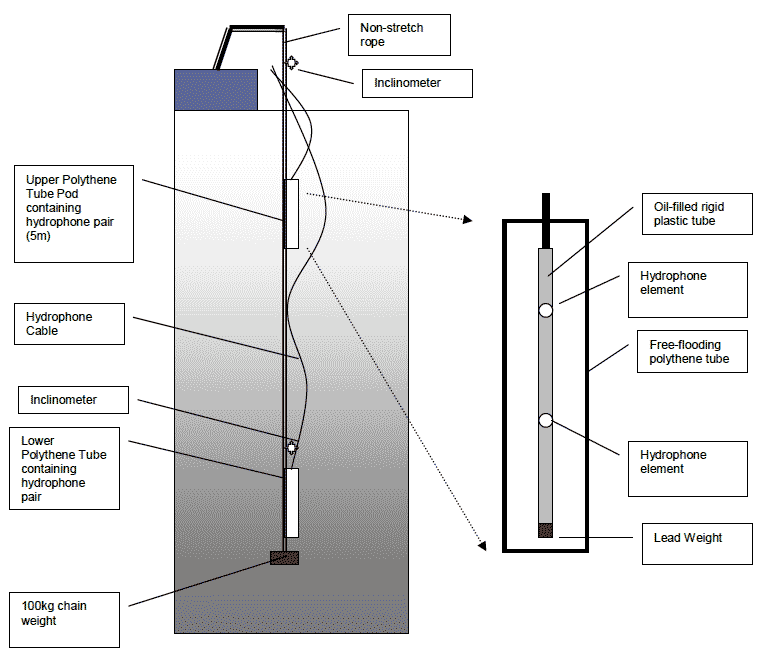
A number of trials were performed in the Kyle Rhea area in May 2011 alongside the surveys outlined in Section 1. These consisted of a calibration experiment with a porpoise-like sound source being moved over a range of depths and distances from the array. An examination of the impact of inclination error was also performed. In addition the array was used to record real porpoise echolocation in two locations. The first was in the relatively still water of Loch Duich and the second was in the tidally influenced northern Sound of Sleat on the ebb tide where a vigorous jet of water crosses the Sound from north-west to south-east. Both of these sites are in relatively deep water extending from 50 to at least 100 m.
The calibration trial showed that it was possible to accurately determine both distance and depth of received porpoise-like clicks out to a range of at least 127 m and depths below 5 m. Over one thousand real porpoise echolocation clicks were then localised in Loch Duich and the northern Sound of Sleat. Overall the depth of these clicks was surprisingly shallow in comparison to both the likely depth of water these sounds were made in (50 - 100 m) and also relative to porpoises studied elsewhere. The mean depth of the clicks detected was just over 10 m deep with a maximum of around 28 m. By linking successive clicks together it was also possible to part-reconstruct individual porpoise dive profiles and dives of between 90 and 120 seconds duration were observed.
This study was set up to test a developing method in a west of Scotland tidal-energy site. It proved successful in showing that the diving behaviour of free-swimming porpoises in tidal areas could be documented to a relatively high degree of accuracy and revealed unexpected shallow diving behaviour in relatively deep water. Of course this method has caveats, most notably that it only works for vocalising animals, but it offers a very practical way to investigate porpoise behaviour in areas of direct interest to the tidal-energy sector and also at all states of the tide.
Figure 21. Histogram of acoustically derived depths for all acoustic porpoise encounters.
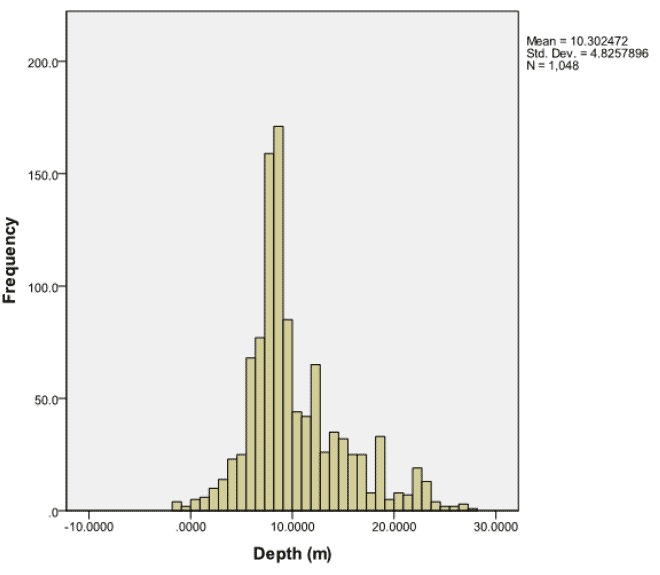
Contact
There is a problem
Thanks for your feedback